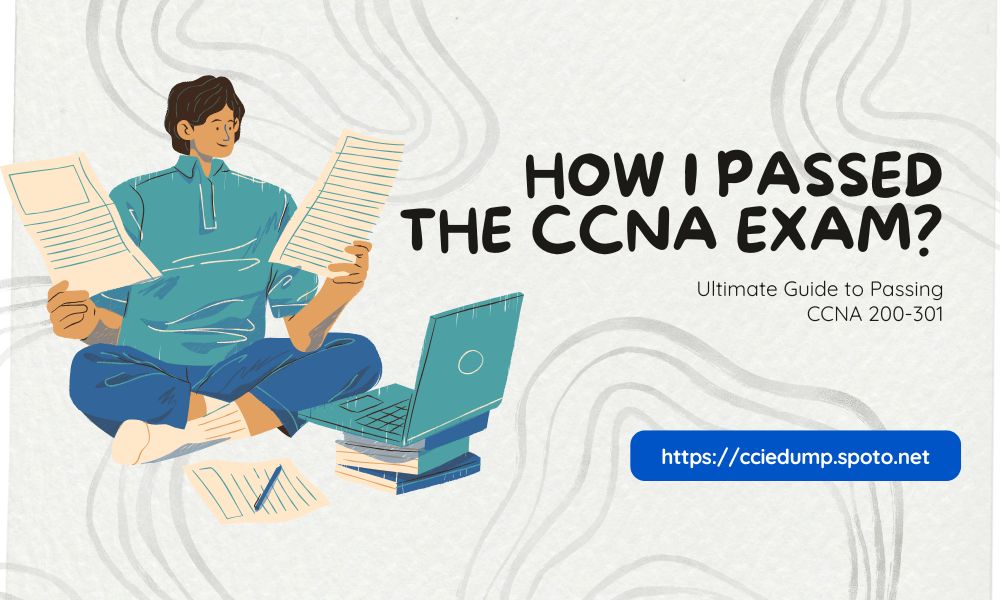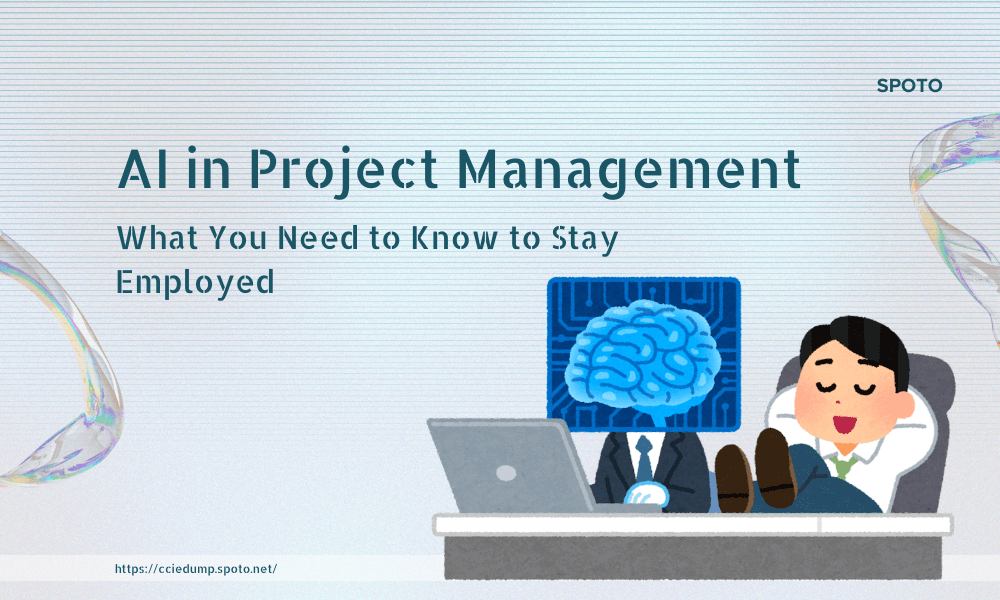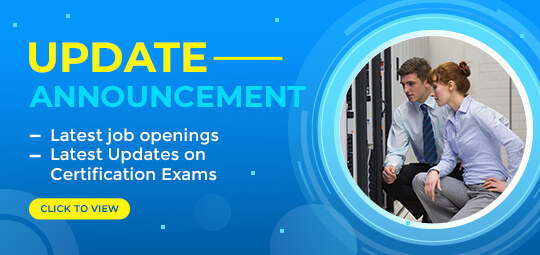TRUSTED BY THE SMARTEST TEAMS IN THE WORLD FOR CERTIFIED CANDIDATES
SPOTO Blogs
Useful learning materials to become certified IT personnel
-
- 958
- SPOTO
- 2025-03-25 14:06
-
- 1338
- circle
- 2025-03-25 11:44
-
- 1206
- circle
- 2025-03-25 11:18
-
- 1071
- SPOTO
- 2025-03-25 11:12
-
- 1104
- circle
- 2025-03-21 15:17
-
- 1234
- circle
- 2025-03-21 11:47
-
- 812
- circle
- 2025-03-20 15:07
-
- 1038
- circle
- 2025-03-20 11:50
-
- 1278
- circle
- 2025-03-19 16:08
TRUSTED BY THE SMARTEST TEAMS IN THE WORLD FOR CERTIFIED CANDIDATES
SPOTO Blogs
Useful learning materials to become certified IT personnel
-
- 958
- SPOTO
- 2025-03-25 14:06
Table of Contents1. Why CCNA Matters in 20252. Exam Blueprint AnalysisTop Tips to Pass the CCNA ExamExam Experience: What to ExpectConclusion The Cisco Certified Network Associate (CCNA) certification is one of the most sought-after credentials in the IT and networking industry. With over 2,000 job opportunities in the European Union, 1,000 in the US, and 1,000 in India, earning this certification can significantly boost your career prospects. In this blog, we'll explore top tips to help you pass the CCNA exam on your first attempt, along with insights into the exam structure and difficulty level. 1. Why CCNA Matters in 2025 The CCNA certification validates your ability to install, operate, and troubleshoot medium-sized routed and switched networks. It's a stepping stone to advanced certifications like CCNP and CCIE, and it's highly valued by employers worldwide. According to the IT Skills and Salary Report by Skillsoft, CCNA ranks alongside AWS and Google Cloud certifications as one of the most desired credentials in the tech industry. 2. Exam Blueprint Analysis The CCNA exam is divided into several key domains, each focusing on essential networking concepts: Network Fundamentals: Covers OSI model, TCP/IP, Ethernet, and wireless technologies. Network Access: Focuses on VLANs, port security, and authentication methods. IP Connectivity: Includes IP addressing, subnetting, and routing protocols like OSPF. IP Services: Covers NAT, DHCP, QoS, and DNS. Security: Focuses on VPNs, ACLs, and device security. Automation and Programmability: Emphasizes APIs, Python, Ansible, and Cisco SDN. Top Tips to Pass the CCNA Exam 1. Master the Fundamentals A solid understanding of networking basics is crucial. Focus on: OSI Model: Understand the seven layers and their functions. TCP/IP Protocol Suite: Learn IP, TCP, UDP, and ICMP protocols. Subnetting: Practice calculating subnets and IP address ranges. Routing Protocols: Familiarize yourself with OSPF and its operations. 2. Hands-On Practice Practical experience is key to mastering CCNA concepts. Use tools like Cisco Packet Tracer or real hardware to: Configure routers and switches. Troubleshoot network issues. Implement security measures like ACLs and VPNs. 3. Diversify Your Learning Resources Use a mix of study materials to deepen your understanding: Online Courses: Platforms like Udemy or SPOTO offer comprehensive CCNA courses. Books: Use official Cisco guides and supplementary materials. Note: You can also download these Cisco study materials from SPOTO website. 4. Take Practice Tests Practice tests are essential for gauging your readiness. Use platforms like SPOTO to: Simulate exam conditions. Identify weak areas. Familiarize yourself with question formats. Exam Experience: What to Expect Difficulty Level The exam is fair and balanced, with questions evenly distributed across domains. If you've prepared thoroughly, you'll find it manageable. Lab Component The labs validate your practical skills and are relatively straightforward if you've practiced extensively. Expect around 100 questions, including 4 performance-based labs. Conclusion Passing the CCNA exam requires a combination of theoretical knowledge, hands-on practice, and strategic preparation. By mastering the fundamentals and utilizing diverse resources, you can confidently earn your certification. Downloadable Resources: https://cciedump.spoto.net/cisco-ebook-download -
- 1338
- circle
- 2025-03-25 11:44
As we embark on the journey into 2025, the world of technology continues to evolve rapidly, with networking playing a pivotal role in connecting everything from personal devices to global enterprises. Among the most esteemed certifications in the networking industry, Cisco's CCNA (Cisco Certified Network Associate) stands out as a gateway to a rewarding career. If you're planning to study for the CCNA exam in 2025, you're making a smart move toward a future filled with exciting opportunities. Here's why and how you should prepare for this esteemed certification. Why Pursue CCNA in 2025? Industry Demand: The demand for skilled network engineers is at an all-time high. With the proliferation of IoT devices, cloud computing, and advanced network architectures, businesses are eager to hire professionals who can design, implement, and troubleshoot complex networks. CCNA-certified professionals are in high demand and command competitive salaries. Future-Proof Skills: The CCNA curriculum is continually updated to reflect the latest trends and technologies in networking. In 2025, the CCNA will cover topics such as automation, security, and emerging wireless technologies, ensuring that you possess the skills needed to thrive in the modern networking environment. Career Advancement: Whether you're just starting your career or looking to advance, CCNA can open doors to new job roles and promotions. It demonstrates your commitment to excellence and serves as a foundation for more advanced certifications like CCNP and CCIE. Global Recognition: Cisco certifications are recognized worldwide. Achieving CCNA status can open opportunities for international work experiences, collaborations, and networking with professionals from diverse backgrounds. How to Prepare for CCNA in 2025? Understand the Exam Format: Familiarize yourself with the exam format, including the number of questions, duration, and types of questions (multiple-choice, drag-and-drop, simulations, etc.). Cisco often updates its exam structures, so ensure you're studying based on the latest information available. Choose the Right Study Materials: Invest in high-quality study materials. Cisco's official curriculum, including books, practice exams, and lab guides, is a great starting point. Additionally, consider online resources such as video tutorials, forums, and practice platforms that can offer real-world scenarios and hands-on experience. Hands-On Experience: Theory alone won't suffice; practical experience is crucial. Set up a home lab with routers, switches, and other networking equipment, or utilize cloud-based labs like Packet Tracer and GNS3. This will allow you to apply theoretical knowledge in practical scenarios, enhancing your understanding and retention. Join Study Groups and Forums: Engage with other CCNA aspirants through study groups, forums, and online communities. Sharing knowledge, solving problems, and discussing exam strategies can significantly enhance your preparation. Plus, it's a great way to stay motivated and accountable. Create a Study Plan: A well-structured study plan is vital for success. Break down the vast CCNA syllabus into manageable chunks, allocate dedicated study hours, and set realistic milestones. Regularly review and adjust your plan based on your progress and understanding. Practice, Practice, Practice: Take practice exams regularly to assess your preparation. This will help you identify areas of strength and weakness, allowing you to focus your studies more effectively. Cisco Learning Network and third-party platforms offer a plethora of practice exams and quizzes. Stay Updated: Networking technologies evolve rapidly. Keep abreast of the latest developments, updates to the CCNA exam, and new study resources. Following Cisco blogs, podcasts, and industry news can provide insights and keep your preparation relevant. Tips for a Successful Exam Day Rest Well: Ensure you're well-rested and mentally prepared for the exam day. A good night's sleep before the exam can make a significant difference. Review Key Concepts: Spend some time reviewing key concepts and formulas on the day of the exam. Eat Healthy: A balanced meal can help maintain your energy levels and focus during the exam. Stay Calm: Stay calm and composed. Remember, preparation is the key to confidence. Take deep breaths and manage your time wisely during the exam. Conclusion Studying for Cisco's CCNA in 2025 is not just about acquiring a certification; it's about equipping yourself with the skills and knowledge to thrive in a dynamic and exciting industry. By following a structured preparation plan, engaging with the right resources, and maintaining a positive mindset, you can unlock your potential and pave the way for a successful networking career. Embrace the challenge, stay committed, and watch your dreams unfold in the thrilling world of networking. Happy studying! -
- 1206
- circle
- 2025-03-25 11:18
In the fast-evolving world of cybersecurity, certifications have become the gold standard for demonstrating expertise and staying ahead of the competition. Among the myriad of credentials available, the Fortinet Certified Professional (FCP) certification stands out as a beacon of advanced knowledge and skill in network security. But the question remains: is investing your time and resources in an FCP certification worth it for a high-paying career? Let's delve into the details to find out. The Growing Demand for Cybersecurity Experts Cyber threats are becoming increasingly sophisticated and prevalent, making cybersecurity a critical component of every organization's infrastructure. According to recent reports, the global cybersecurity market is projected to reach staggering heights in the coming years. With this growth, the demand for skilled cybersecurity professionals is skyrocketing. Enterprises are willing to pay top dollar for individuals who can protect their digital assets. A certification like FCP, which validates your expertise in deploying, managing, and troubleshooting Fortinet security solutions, positions you as a valuable asset in this high-demand field. What is FCP Certification? The Fortinet Certified Professional certification is a rigorous program designed to test and validate your proficiency in advanced Fortinet technologies. Candidates must demonstrate a deep understanding of Fortinet's security solutions, including FortiGate, FortiManager, FortiAnalyzer, and more. The certification process typically involves: Prerequisites: Possessing foundational knowledge and possibly holding lower-level Fortinet certifications. Training: Completing comprehensive training courses or self-study materials. Exam: Passing a challenging, hands-on exam that tests your practical skills and theoretical knowledge. The FCP credential signifies that you have mastered the intricacies of Fortinet's security offerings, making you an invaluable resource for organizations leveraging these technologies. The Benefits of FCP Certification Enhanced Credibility and Trust: Holding an FCP certification sets you apart as a subject matter expert in Fortinet security solutions. Potential employers and clients recognize the rigorous standards of the FCP program, increasing your credibility in the job market. Increased Job Opportunities: Many job postings for high-level cybersecurity roles specifically request FCP certification. You'll have access to a broader range of job opportunities, including consulting, technical support, and senior-level management positions. Higher Salary Potential: Certified professionals often command higher salaries due to their specialized skills and expertise. With FCP certification, you can negotiate a more competitive salary package, especially in high-demand sectors like finance, healthcare, and government. Access to Exclusive Resources and Networks: As an FCP, you'll gain access to Fortinet's community of experts, forums, and special events. These resources can help you stay updated on the latest trends, technologies, and best practices in cybersecurity. Personal and Professional Growth: Pursuing certification challenges you to expand your knowledge and skills, fostering continuous personal and professional growth. The FCP program's focus on practical skills ensures that you remain relevant and effective in your role. The Investment: Time and Money Of course, there's an investment involved in earning an FCP certification. Training courses, study materials, and exam fees can add up. However, you must weigh this against the potential long-term benefits. Many organizations, recognizing the value of certified professionals, may offer financial support for certification programs. Additionally, personal satisfaction and career advancement opportunities often far outweigh the initial costs. Real-World Testimonials Numerous cybersecurity professionals have attested to the transformative impact of FCP certification on their careers. From landing dream jobs to securing significant salary hikes, the stories of FCP holders are inspiring and encouraging. For instance, John, a seasoned cybersecurity analyst, shared how his FCP certification opened doors to consulting roles with top-tier companies, resulting in a substantial increase in his earnings. Similarly, Sarah, a network engineer, credited her FCP certification with providing her with the skills and confidence to lead her team in deploying complex security solutions. Conclusion In summary, an FCP certification is indeed worth it for a high-paying career in cybersecurity. It not only validates your expertise but also opens doors to exciting job opportunities, higher salaries, and professional growth. As the cybersecurity landscape continues to evolve, staying ahead requires a commitment to continuous learning and development. An FCP certification is a powerful tool that can help you navigate this dynamic field with confidence and expertise. So, if you're ready to take your cybersecurity career to the next level, consider embarking on the journey to become a Fortinet Certified Professional. The investment in your future will undoubtedly pay off. -
- 1071
- SPOTO
- 2025-03-25 11:12
Table of ContentsThe Impact of AI on Project ManagementHow to Stay Relevant in the Age of AIRecommended ResourcesConclusion Artificial Intelligence (AI) is reshaping industries worldwide, and project management is no exception. While AI offers incredible opportunities to streamline processes and enhance efficiency, it also poses challenges—particularly for professionals who fail to adapt. In this blog, we'll explore how AI is impacting project management, what it means for your career, and actionable steps to ensure you stay relevant in this evolving landscape. The Impact of AI on Project Management 1. Automation of Routine Tasks AI is already automating many routine project management tasks, such as: Scheduling: AI tools can create and optimize project schedules. Risk Management: AI can identify and mitigate risks more efficiently. Budgeting: AI can analyze financial data and predict budget overruns. According to a Gartner report, 80% of project management tasks will be run by AI by 2030. While this increases efficiency, it also means that roles focused solely on these tasks may become obsolete. 2. Enhanced Decision-Making AI can analyze vast amounts of data to provide insights and recommendations, enabling project managers to make more informed decisions. However, this also means that professionals who rely solely on manual analysis may struggle to compete. 3. Shift in Skill Requirements As AI takes over routine tasks, the demand for higher-level skills is increasing. Project managers now need to focus on: Strategic Thinking: Aligning projects with organizational goals. Stakeholder Management: Building and maintaining relationships. AI Proficiency: Leveraging AI tools to enhance productivity. How to Stay Relevant in the Age of AI 1. Embrace AI as a Co-Pilot Rather than viewing AI as a threat, think of it as a digital assistant that can enhance your capabilities. Use AI tools to: Automate Repetitive Tasks: Free up time for strategic work. Generate Insights: Leverage AI for data analysis and decision-making. Improve Communication: Use AI to draft emails, reports, and presentations. 2. Reskill and Upskill To stay competitive, invest in learning how to use AI effectively. Key areas to focus on include: Prompt Engineering: Mastering the art of crafting effective prompts for AI tools. AI Tools for Project Management: Familiarize yourself with tools like ChatGPT, Gemini, and PMI's Infinity. Data Analysis: Learn how to interpret and apply AI-generated insights. 3. Develop Soft Skills While AI can handle technical tasks, it cannot replicate human skills like: Emotional Intelligence: Building trust and rapport with stakeholders. Leadership: Inspiring and guiding teams. Creativity: Solving complex problems and innovating. 4. Stay Updated on AI Trends AI is evolving rapidly, and staying informed is crucial. Follow industry news, attend webinars, and take courses to keep your knowledge up-to-date. Recommended Resources 1. AI for Project Managers Course Andrew Ramdayal's AI for Project Managers course on Udemy provides a comprehensive guide to leveraging AI in project management. The course covers: Introduction to AI: Understanding the basics of AI and large language models. AI Tools: Exploring tools like ChatGPT, Gemini, and PMI's Infinity. Practical Applications: Using AI for project planning, risk management, and more. 2. Harvard Business Review Article The article "Four Factors That Will Help Project Managers Fulfill AI's Potential" offers valuable insights into how AI is transforming project management. 3. SPOTO AI Training Courses for Project Managers SPOTO offers some AI-powered courses tailored specifically for project managers, designed to equip you with cutting-edge skills and strategies to excel in today's dynamic project environments. Click here: https://cciedump.spoto.net/train/pmp-bootcamp-exam-prep Conclusion AI is transforming project management, and while it presents challenges, it also offers opportunities for those who adapt. By embracing AI as a co-pilot, reskilling, and focusing on soft skills, you can ensure you remain relevant and thrive in this new era. Downloadable Resources:https://cciedump.spoto.net/deepseek-r1-ebook-technical-report -
- 1104
- circle
- 2025-03-21 15:17
In the rapidly evolving landscape of cybersecurity, acquiring specialized certifications can significantly enhance your career prospects and technical expertise. One such certification that stands out is the Fortinet Certified Solution Specialist (FCSS) credential. This certification validates your proficiency in designing, implementing, and troubleshooting Fortinet solutions, making you an invaluable asset to any IT team. If you're embarking on the journey to become an FCSS, having a clear roadmap can make the path more manageable and less intimidating. Here's a step-by-step timeline to guide you through the process. Step 1: Self-Assessment and Preparation (1-2 Weeks) Objective: Evaluate your current knowledge and skills to determine your readiness for the FCSS certification. Review the Exam Requirements: Visit the Fortinet Certification Program page to understand the prerequisites, exam format, and content outline. Self-Assessment Tools: Utilize online practice tests and quizzes to gauge your knowledge level. Consider taking a skills inventory to identify areas where you need improvement. Set a Timeline: Plan your study schedule around your current work and personal commitments. Allocate at least 1-2 weeks for this initial preparation phase. Step 2: Foundational Knowledge Building (4-6 Weeks) Objective: Build a strong foundation in networking and cybersecurity concepts, with a focus on Fortinet products. Study Materials: Obtain official Fortinet study guides and reference books. Access online resources such as Fortinet's training portal and community forums. Hands-On Experience: Gain practical experience by working with Fortinet products in a lab environment. Consider joining hands-on workshops or boot camps if possible. Structured Study Plan: Allocate daily study hours, aiming for at least 2-3 hours per day. Use weekends for review sessions and mock exams. Step 3: Specialized Training (2-4 Weeks) Objective: Deepen your understanding of Fortinet solutions through formal training courses. Enroll in Training Courses: Register for Fortinet's authorized training courses, either online or in-person. Focus on courses that align with the FCSS exam objectives. Interactive Learning: Engage in interactive sessions, discussions, and lab exercises during the training. Network with peers and instructors to gain insights and support. Continuous Practice: Use the skills acquired in training to solve real-world scenarios and case studies. Regularly review and revise key concepts to retain information. Step 4: Exam Preparation and Practice (2-3 Weeks) Objective: Focus on exam-specific preparation to boost your confidence and readiness. Exam Simulations: Take full-length practice exams under timed conditions to simulate the actual exam environment. Review your performance to identify areas needing improvement. Focused Study: Concentrate on weak areas identified through practice exams. Create flashcards and summary notes for quick revision. Mental Preparation: Practice relaxation techniques to manage exam anxiety. Ensure you have a good night's sleep and a nutritious meal before the exam day. Step 5: Scheduling and Taking the Exam (1 Week) Objective: Schedule and successfully complete the FCSS exam. Exam Scheduling: Register for the exam through the Fortinet Certification Program portal. Choose a date and location that suits your schedule, ensuring it falls within your planned timeline. Exam Day Preparation: Bring all necessary materials, such as a valid ID and any required authorization letters. Arrive at the exam center early to avoid last-minute stress. Taking the Exam: Read the exam instructions carefully before starting. Manage your time effectively, allocating sufficient time to each question. Stay calm and focused throughout the exam. Step 6: Post-Exam and Certification (Immediate to 1 Week) Objective: Review your exam performance and claim your certification. Exam Review: Upon completion, review your exam performance if possible to understand your strengths and weaknesses. Use this feedback to further enhance your skills. Certification Claiming: Once you pass the exam, follow the instructions provided by Fortinet to claim your FCSS certification. Receive your certification badge and digital certificate. Continuous Learning: Stay updated with the latest Fortinet products and technologies. Consider pursuing advanced certifications to further enhance your career. Conclusion Achieving the FCSS certification is a significant milestone in your cybersecurity journey. By following this step-by-step timeline, you can systematically prepare, build your knowledge, and ultimately succeed in the exam. Remember, consistent effort, dedication, and a well-structured plan are key to your success. Happy studying, and best of luck on your FCSS certification journey! -
- 1234
- circle
- 2025-03-21 11:47
In the fast-paced world of information technology, breaking into the industry can be challenging, especially for those with limited experience. For one man I knew, this was no exception. Starting at the bottom, he spent just over a year working in a help desk role, feeling stuck and eager for a way to advance his career. That's when he decided to take a leap and pursue the Cisco Certified Network Associate (CCNA) certification. His journey, filled with hard work and determination, paid off in unexpected ways, transforming his career trajectory in a remarkable way. The Decision to Pursue CCNA After a year of working in a help desk position, it became increasingly clear that he needed to take the next step to progress in his IT career. With no other IT experience to speak of, he knew he had to start somewhere, and the CCNA certification seemed like the perfect fit. Networking was an area he was passionate about, and obtaining this certification would provide him with the skills and knowledge necessary to break into more traditional networking roles. He dedicated himself to studying for the CCNA, putting in long hours and focusing intently on the material. With a well-structured study plan and a commitment to excellence, he was able to knock out the certification in just 3.5 months. This was a significant accomplishment, but it was just the beginning of his journey. The Impact of CCNA Certification While it's impossible to say that the CCNA certification alone was the sole factor that led to his career advancement, there's no denying that it played a crucial role. The knowledge and skills he gained while studying for the certification were invaluable, and they provided him with a solid foundation for the technical interview that ultimately landed him a new job. Just one month after achieving his CCNA certification, he landed a job that would eventually lead him to his current position. In this role, he does a mix of operations and engineering work on several hundred Nokia routers and switches. He's progressing towards a Nokia certification to specialize further in service-provider networks, a testament to his dedication to continuous learning and growth. But the CCNA's impact wasn't just about landing a new job. The certification also provided him with a sense of accomplishment and confidence. He knew that he had put in the hard work and dedication to earn this credential, and that knowledge gave him the confidence to pursue new opportunities and challenges. The Role of Other Certifications and Education While the CCNA was a significant step in his career advancement, it's worth noting that he had other certifications and educational background that also played a role. He holds a bachelor's degree and the CompTIA trifecta—a combination of three certifications in A+, Network+, and Security+. These certifications, combined with his CCNA, demonstrate a well-rounded skill set and a commitment to ongoing education and professional development. In the IT industry, certifications are often seen as a way to validate skills and knowledge. While they are not the only factor in landing a job or advancing in a career, they can certainly open doors and provide opportunities for growth. For this man, having a combination of certifications and educational background gave him a competitive edge in the job market and helped him stand out to potential employers. The Importance of Continuous Learning The IT industry is constantly evolving, and staying up-to-date with the latest trends and technologies is crucial for career success. He has taken this to heart, demonstrating a commitment to continuous learning and growth throughout his career. In addition to his certifications, he has sought out opportunities for hands-on experience and professional development. He has taken on projects that challenge him and push him out of his comfort zone, and he has sought out mentorship and guidance from more experienced professionals in the industry. This commitment to continuous learning has not only helped him advance in his career but has also made him a more well-rounded and valuable professional. He is confident in his skills and knowledge, and he is always looking for ways to improve and grow. Conclusion In conclusion, obtaining the CCNA certification was a significant step in this man's career advancement. While it's impossible to say that the certification alone was the sole factor that led to his success, there's no denying that it played a crucial role. The knowledge and skills he gained while studying for the certification were instrumental in landing him a new job and providing him with the foundation he needed to progress in his career. His journey serves as an inspiration to others who may be feeling stuck in their current roles or who are looking for ways to break into the IT industry. With dedication, hard work, and a commitment to continuous learning, the possibilities are endless. So, if you're ready to take the next step in your career, consider pursuing a CCNA certification and see where it takes you. -
- 812
- circle
- 2025-03-20 15:07
In the ever-evolving world of technology, earning a Cisco Certified Network Associate (CCNA) certification is a pivotal milestone for aspiring and seasoned engineers alike. This credential not only validates your expertise in networking fundamentals but also opens doors to lucrative career opportunities. But how do top engineers effectively prepare for such a rigorous exam? What secrets do they hold that make their journey smoother and more successful? Let's dive into the study habits and strategies of these high achievers. 1. Master the Syllabus: Understand What Matters Most Top engineers start their CCNA preparation by thoroughly reviewing the exam syllabus. They don't just skim through it; they meticulously analyze each topic to understand its importance and relevance. This helps them prioritize their study materials and focus on areas that are most likely to appear on the exam. They often create a detailed study plan, breaking down the syllabus into manageable chunks and setting realistic deadlines for each. 2. Leverage Quality Study Resources When it comes to study materials, top engineers are selective. They rely on official Cisco resources like the CCNA Routing and Switching study guide, practice exams, and lab manuals. Additionally, they often supplement these with reputable third-party books, online courses, and forums. They understand the value of diversity in resources, as different materials can offer unique perspectives and explanations that can clarify complex concepts. 3. Practice, Practice, Practice One of the most crucial secrets of top engineers is their relentless focus on practice. They don't just read and memorize; they apply their knowledge through hands-on practice. This means setting up home labs with Cisco equipment or using simulation tools like Packet Tracer and GNS3. They also regularly take practice exams to assess their preparedness and identify areas needing improvement. 4. Join Study Groups and Forums Top engineers deeply recognize the power of collaboration. They participate in study groups and forums actively where they can discuss complex topics, share tips, and provide mutual support. These interactions not only broaden their understanding but also help them stay motivated and engaged. Many find that explaining concepts to others reinforces their own learning and helps solidify their grasp of the material. 5. Time Management: Study Smart, Not Hard Effective time management is another hallmark of top engineers. They understand the importance of balancing their study time with rest and other commitments. They create study schedules that are realistic and sustainable, incorporating regular breaks to avoid burnout. They also use techniques like Pomodoro to maintain focus and productivity during their study sessions. 6. Stay Updated with Current Technologies Networking is a dynamic field, and CCNA exams often include questions on the latest technologies and trends. Top engineers stay ahead by regularly reading industry publications, attending webinars, and participating in conferences. This not only keeps them informed but also provides real-world context to their theoretical knowledge, making the learning process more engaging and meaningful. 7. Mind Maps and Visualization Techniques Some top engineers swear by mind mapping and visualization techniques to organize complex information. By creating visual representations of networking concepts, they can better understand relationships and hierarchies, which aids memory retention. Tools like MindMeister or XMind can be invaluable in this process. 8. Seek Mentorship and Feedback Experienced mentors can provide invaluable insights and guidance. Top engineers often seek out mentors who have successfully earned their CCNA or higher-level certifications. They value the advice, feedback, and real-world experiences shared by these mentors, which can help them navigate the certification process more efficiently. 9. Stay Positive and Resilient Lastly, top engineers maintain a positive mindset and resilience throughout their preparation journey. They understand that setbacks and failures are part of the learning process. When faced with challenges, they don't give up; they persevere and learn from their mistakes. This mental toughness is a key ingredient in their success formula. Conclusion Earning a CCNA certification is a significant achievement that requires dedication, hard work, and smart study strategies. By adopting the secrets of top engineers—mastering the syllabus, leveraging quality resources, practicing relentlessly, collaborating with peers, managing time effectively, staying updated, using visualization techniques, seeking mentorship, and maintaining a positive mindset—you can embark on a similar path of success. Remember, the journey may be challenging, but the rewards are well worth it. So, roll up your sleeves, dive into your studies, and let the journey to CCNA begin! -
- 1038
- circle
- 2025-03-20 11:50
In the fast-paced world of information technology, staying competitive and relevant can be a daunting challenge. Whether you're a seasoned professional or an aspiring tech enthusiast, advancing your career often requires more than just skill and experience. It demands validation—a tangible proof of your expertise that sets you apart from the crowd. This is where certifications come in, and among the most esteemed in the industry is the Cisco Certified Network Professional (CCNP) credential. The Ever-Evolving IT Landscape The IT sector is marked by rapid advancements and evolving technologies. From cloud computing and artificial intelligence to cybersecurity and the Internet of Things (IoT), the landscape is continuously shifting. With such dynamic changes, staying updated with the latest trends and technologies is crucial for career growth. Employers are increasingly looking for professionals who not only have the practical skills but also the official recognition of their expertise. What is CCNP Certification? Cisco certifications are globally recognized as a benchmark of networking excellence. The CCNP certification is a professional-level credential that validates your skills in designing, implementing, and troubleshooting complex enterprise network infrastructures. It builds on the foundation laid by the Cisco Certified Network Associate (CCNA) certification and takes you to the next level of proficiency. The CCNP program covers a wide range of specialties, including: Security Enterprise Service Provider Collaboration Data Center DevNet CyberOps By achieving CCNP certification in any of these areas, you demonstrate a deep understanding of advanced networking concepts and technologies. Why CCNP is a Game-Changer Enhanced Credibility: A CCNP certification instantly boosts your credibility in the job market. It tells employers and peers that you have passed rigorous exams, proving your mastery of advanced networking skills. This credibility can open doors to better job opportunities and higher salaries. Specialized Knowledge: Pursuing CCNP means diving deep into specialized networking domains. You gain a comprehensive understanding of the latest technologies, architectures, and best practices. This expertise can be invaluable in solving real-world network challenges and implementing innovative solutions. Career Advancement: Whether you're aiming for a promotion within your current organization or looking to switch to a more prestigious role, CCNP can be a significant boost. Many job roles, such as network engineer, network architect, and network manager, specifically require or prefer CCNP-certified professionals. Expanded Networking Opportunities: Being part of the Cisco Certified Professionals community provides access to a vast network of like-minded professionals. This can lead to collaboration opportunities, mentorship, and even new job leads. Cisco also offers continued education resources and professional development opportunities to its certified individuals. Demand and Recognition: The demand for CCNP-certified professionals is consistently high. As businesses increasingly rely on robust and secure network infrastructures, they seek out individuals with proven expertise. Holding a CCNP certification sets you apart as a top candidate for high-stakes projects and leadership roles. The Path to CCNP Certification Achieving CCNP certification involves dedication and hard work, but it's a journey well worth taking. Here's a broad outline of the path you might follow: Prerequisites: Typically, you'll need to have a valid CCNA certification or equivalent experience before enrolling in CCNP training. Training and Study: Utilize a combination of self-study, formal training courses, and hands-on practice. Cisco and other credible platforms offer various training resources, including online courses, boot camps, and practice exams. Exam Preparation: Focus on understanding the exam objectives thoroughly and practicing with real-world scenarios. Utilize study groups, forums, and simulation tools to reinforce your learning. Certification Exams: Successfully passing one or more exams (depending on your chosen specialty) will earn you the CCNP credential. Make sure to stay updated on exam formats and content changes. The ROI of CCNP Certification The investment of time and resources required to obtain CCNP certification may seem significant, but the returns are well worth it. According to various industry reports and salary surveys, CCNP-certified professionals often earn higher salaries and enjoy faster career progression than their non-certified peers. Moreover, the skills and knowledge you gain through the certification process are invaluable for personal and professional growth. They not only make you more effective in your current role but also prepare you for future advancements in the field. Conclusion In a world where technology is continually evolving, having a CCNP certification can be your ticket to a fulfilling and successful IT career. It opens doors to better job opportunities, higher salaries, and deeper professional connections. By demonstrating your mastery of advanced networking concepts, you position yourself as a valuable asset to any organization. Don't let your career stagnate. Embrace the challenge, invest in your future, and earn the Cisco Certified Network Professional credential. Your journey to excellence begins now! -
- 1278
- circle
- 2025-03-19 16:08
Table of Contents1. Understand the Exam Blueprint2. Create a Structured Study Plan3. Leverage Quality Study Resources4. Practice, Practice, Practice5. Join Study Groups6. Take Regular Breaks7. Understand the Technology, Not Just the Exam8. Use Flashcards and Mind Maps9. Stay Updated10. Take Mock Exams SeriouslyConclusion Embarking on the journey to become a Certified Cisco Network Associate (CCNA) can be both exciting and challenging. This certification is a cornerstone for networking professionals, providing a wide range of opportunities in the ever-evolving tech industry. However, with the complexity and breadth of material covered, it's essential to have a solid strategy to ensure your success. Here, we've compiled a suite of proven study tips that will guide you through the process, making your path to CCNA mastery both efficient and effective. 1. Understand the Exam Blueprint Before diving into your studies, familiarize yourself with the CCNA exam blueprint. The document outlines the topics you need to master, including networking fundamentals, routing and switching technologies, security, and troubleshooting. By knowing what to expect, you can tailor your study plan to focus on the most critical areas, ensuring no stone is left unturned. 2. Create a Structured Study Plan Success in any certification exam begins with a well-organized study plan. Break down the material into manageable chunks and allocate specific time slots for each topic. Mix in practice sessions, review periods, and mock exams to keep your learning dynamic and engaging. Consistency is key; aim for daily study sessions rather than cramming at the last minute. 3. Leverage Quality Study Resources The internet is awash with study materials, but not all are created equal. Invest in reputable resources such as the official Cisco CCNA curriculum, practice exams from reliable providers, and comprehensive textbooks. Don't overlook online forums and communities where you can exchange knowledge and get insights from fellow aspirants and seasoned professionals. 4. Practice, Practice, Practice Theoretical knowledge is crucial, but applying it through practical exercises is where true understanding lies. Utilize lab environments, either physical or virtual (like Cisco Packet Tracer), to simulate real-world scenarios. This hands-on experience will reinforce your learning and prepare you for the practical aspects of the exam. 5. Join Study Groups Studying in isolation can be lonely and demotivating. Join CCNA study groups or forums where you can discuss topics, share resources, and provide mutual support. Collaborative learning can reveal new perspectives, clarify doubts, and keep you motivated through the tough spots. 6. Take Regular Breaks Studying is mentally demanding, and taking regular breaks is vital to maintain productivity and retain information. Use techniques like the Pomodoro Technique, which involves studying for 25 minutes followed by a 5-minute break, to keep your sessions fresh and focused. 7. Understand the Technology, Not Just the Exam While passing the exam is the ultimate goal, focus on truly understanding the underlying technologies. This deeper comprehension will not only help you ace the exam but also serve you well in your future career. Networking is a dynamic field, and a solid foundation will enable you to adapt and grow. 8. Use Flashcards and Mind Maps Visual and repetitive learning tools like flashcards and mind maps can significantly enhance memory retention. Create your own or utilize pre-made decks tailored to the CCNA syllabus. Regularly reviewing these tools will help embed key concepts in your long-term memory. 9. Stay Updated Cisco technologies and exams evolve continuously. Keep abreast of any changes in the exam format, new topics, or updates to the CCNA curriculum. Subscribing to Cisco's official blog, newsletters, and forums will ensure you're always in the loop. 10. Take Mock Exams Seriously Mock exams are invaluable for assessing your preparedness. Treat each one as a real exam, adhering to the same time constraints and conditions. Analyze your performance thoroughly, identifying areas of strength and weakness. Use this feedback to adjust your study plan and focus on improvement. Conclusion Achieving CCNA certification is a significant milestone in your networking career, but it doesn't have to be horrible. By following these proven study tips, you'll be well-equipped to tackle the exam with confidence and emerge victorious. Remember, the journey is as important as the destination; embrace the learning process, stay focused, and your success is guaranteed. Now, it's time to roll up your sleeves and get started on your path to CCNA mastery. Good luck!














